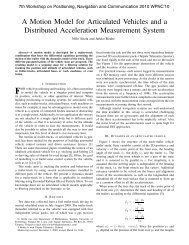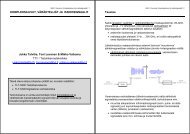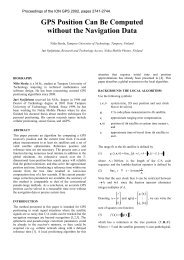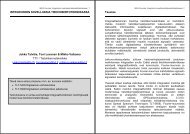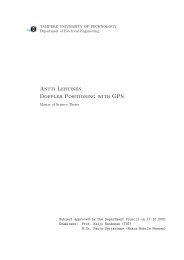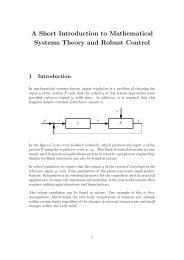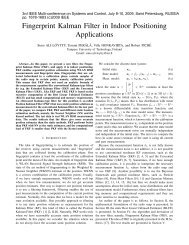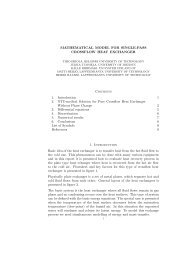Robust Extended Kalman Filtering in Hybrid Positioning Applications
Robust Extended Kalman Filtering in Hybrid Positioning Applications
Robust Extended Kalman Filtering in Hybrid Positioning Applications
You also want an ePaper? Increase the reach of your titles
YUMPU automatically turns print PDFs into web optimized ePapers that Google loves.
4th WORKSHOP ON POSITIONING, NAVIGATION AND COMMUNICATION 2007 (WPNC’07), HANNOVER, GERMANY<br />
A. The ɛ-contam<strong>in</strong>ated normal neighborhood<br />
Huber [2] considered the case<br />
contam<strong>in</strong>ated normal neighborhood<br />
where F is the ɛ-<br />
Fɛ = {F | F =(1−ɛ)φ + ɛH,<br />
H cont<strong>in</strong>uous symmetrical pdf}, (14)<br />
where φ is the standard normal probability density and H is a<br />
cont<strong>in</strong>uous symmetrical probability density function. The least<br />
favorable density for the ɛ-contam<strong>in</strong>ated normal neighborhood<br />
is<br />
p 0 <br />
(1−ɛ) 1<br />
√ − e 2<br />
ɛ(θ) = 2π θ2,<br />
|θ|≤ k<br />
(1−ɛ)<br />
√ e<br />
2π 1<br />
2 k2 (15)<br />
−k|θ| , |θ|> k<br />
where the threshold parameter k is given by<br />
2φ(k)<br />
ɛ<br />
− 2Φ(−k) =<br />
k 1 − ɛ<br />
(16)<br />
φ is the standard normal pdf and Φ the standard normal cdf.<br />
The correspond<strong>in</strong>g m<strong>in</strong>-max robust estimator is based on the<br />
maximization of the likelihood score of the least favorable<br />
density, namely<br />
sH(θ) = ∂<br />
∂θ ln p0 <br />
−θ,<br />
ɛ(θ) =<br />
−k sign(θ),<br />
|θ|≤ k<br />
|θ|> k<br />
(17)<br />
Filters us<strong>in</strong>g this score function are labelled ”H”.<br />
B. The p-po<strong>in</strong>t family<br />
Mart<strong>in</strong> and Masreliez [3] assert that if F is the p-po<strong>in</strong>t<br />
family<br />
−yp<br />
Fp = {F | F (θ)dθ = p/2 =Φ(−yp),<br />
−∞<br />
F symmetric and cont<strong>in</strong>uous at ± yp}, (18)<br />
where Φ is the standard normal cumulative distribution function,<br />
then the correspond<strong>in</strong>g least favorable density is given<br />
by<br />
p 0 <br />
2 θ K cos ( ), |θ|≤ yp<br />
2myp<br />
p(θ) =<br />
K cos2 ( 1<br />
2m )e2Kp−1 cos 2 ( 1<br />
2m )(yp−|θ|) , |θ|> yp<br />
(19)<br />
where K =(1−p)(yp(1 + m s<strong>in</strong>( 1<br />
m )))−1 and m is given by<br />
<br />
2m − p 1+tan 2<br />
<br />
1<br />
1<br />
2m +tan =0 (20)<br />
2m<br />
2m<br />
The likelihood score of the least favorable density of the ppo<strong>in</strong>t<br />
family Fp is<br />
sM(θ) = ∂<br />
∂θ ln p0 <br />
1 − myp<br />
p(θ) =<br />
tan( θ ), 2myp<br />
−<br />
|θ|≤ yp<br />
1<br />
C. Estimators without densities<br />
The m<strong>in</strong>-max robust estimators depend on the shape of<br />
the least favorable density. However, <strong>in</strong> more sophisticated<br />
robust filter design, it might be more appropriate to model the<br />
score function to correspond to the specific problem <strong>in</strong>stead<br />
of f<strong>in</strong>d<strong>in</strong>g the appropriate contam<strong>in</strong>ation classes and the least<br />
favorable densities. Andrews et. al [4] propose a three-partsredescend<strong>in</strong>g<br />
estimator which is basically a heuristic modification<br />
of the estimator proposed by Huber. Because redescend<strong>in</strong>g<br />
estimators reject certa<strong>in</strong> measurements a modified version of<br />
the three-parts-redescend<strong>in</strong>g estimator is proposed here. The<br />
score function is given by<br />
⎧<br />
⎨ θ, |θ|≤ k1<br />
sD(θ) = k1 sign(θ), k1 < |θ|≤ k2 (22)<br />
⎩ k1k2<br />
θ , |θ|> k2<br />
where the threshold parameters k1 and k2 are chosen to fit the<br />
problem. In this work k1 is solved as k <strong>in</strong> (16) and k2 =1.5k1.<br />
Filters us<strong>in</strong>g this score function are labelled ”D”.<br />
IV. ROBUST KALMAN FILTERING<br />
In the previous section we have def<strong>in</strong>ed some ”robust”<br />
densities and their correspond<strong>in</strong>g scores. In this section we<br />
proceed to describe two different ways that these could be<br />
used to robustify the extended <strong>Kalman</strong> filter.<br />
A. Weighted least squares filter<strong>in</strong>g<br />
The first approach is based on the robust <strong>Kalman</strong> filter<strong>in</strong>g<br />
studies of Carosio et. al [5]. The <strong>Kalman</strong> filter can be shown<br />
to be equivalent to a determ<strong>in</strong>istic least squares problem<br />
[6]. The filter is made more robust by replac<strong>in</strong>g the least<br />
squares score function by the score functions <strong>in</strong>troduced <strong>in</strong> the<br />
previous section. By approximat<strong>in</strong>g the derivative of the score<br />
function with a l<strong>in</strong>ear approximation the problem is modified<br />
to a weighted least squares problem, where the weights are<br />
calculated us<strong>in</strong>g the components of the <strong>in</strong>novation vector and<br />
a weight<strong>in</strong>g function that corresponds to the selected score<br />
function. This approach produces filters that give less <strong>in</strong>fluence<br />
to measurements that are classified as blunder.<br />
The state update equation and the measurement equation of<br />
the EKF given <strong>in</strong> (8) may be written as<br />
<br />
−<br />
I<br />
ˆx<br />
xk = k<br />
Gk−1(xk−1 − ˆxk−1)+wk−1<br />
+<br />
Hk yk<br />
−vk<br />
(23)<br />
To make the equations look more simple def<strong>in</strong>e<br />
<br />
Gk−1(xk−1 − ˆxk−1)+wk−1<br />
ek =<br />
(24)<br />
−vk<br />
Now<br />
E(ek) =0, V(ek) =E(eke<br />
1 tan( myp 2m )sign(θ),<br />
Filters us<strong>in</strong>g this score function are labelled ”M”.<br />
|θ|> yp<br />
(21)<br />
T <br />
ˆP −<br />
k )= k 0<br />
(25)<br />
0 Rk<br />
where ˆ P −<br />
k and Rk are symmetric positive def<strong>in</strong>ite and thus<br />
non-s<strong>in</strong>gular. Now def<strong>in</strong>e square matrix Mk such that<br />
M T −1<br />
ˆP −<br />
k Mk = k 0<br />
(26)<br />
57<br />
0 Rk




